This is a really fun article. Read it and laugh, I hope.
How To Tell If You’re In A Hemingway Novel
All about Hemingway
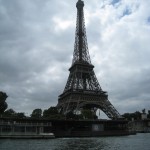
More photos: Some repeat background. Forgive me! But much is new!
We had rented an apartment in the Marais district and it was perfect. It had a security code to get into a beautiful flowered courtyard and then it was two flights up by foot. The apartment itself was quaint, although modern, bright, and sunny.
Efficient use of space was inspiring and I took photos because I was very impressed at how comfortable it was despite its small footprint. The neighborhood was very walkable. If you are not familiar with the Marais district, it is full of narrow roads, two to three story buildings only, the old Jewish district, and boutiques that are open even on Sundays. One street is closed to traffic and it has Jewish/Middle Eastern influence with gourmet falafel creation raised to a fine competitive art.
I would get up early each morning quite early, take a walk around several blocks, stop at a patisserie to get a fresh loaf of bread and croissants, and then buy cheeses at a nearby grocery. It was wonderful to have coffee and breakfast right in the apartment.
Paris, of course, has changed vastly since Hemingway’s days there. Nevertheless, I walked through the areas that he walked through and saw what I could. Shakespeare & Company is still there. The cafes in Saint Germaine dePres may have different names, but they are similar. Les Deux Magotz is still there on a busy corner. I had fun pretending that I could see Hemingway sitting at a corner table, deep in thought, and writing the book that ultimately became The Sun Also Rises. Alternatively, I could imagine him writing one of his reporting pieces that paid bills along with Hadley’s trust while he waited for his big break.
I walked along the Seine, up to Montmartre, and I saw the first apartment that he and Hadley shared. Of course, we didn’t go in it since it’s occupied but I saw the neighborhood.
I was recently listening to some tapes that Alice Sokoloff made of her friend, Hadley Hemingway Mowrer. All of these tapes ultimately became the book that Alice wrote about Hadley. Hadley was describing in this particular conversation the bad neighborhood that she and Ernest had lived in, its unpleasant smell since they were near a lumberyard, and her loneliness in Paris initially. I’d never been aware of that loneliness prior to listening to the tape. I had always had the impression that Hadley was happy in Paris from day one because Hemingway was happy. In this tape, she described how difficult it was without knowing the language, and, given the fact that he was away during the day writing, she felt like an outsider who did not yet have friends. She was quite homesick. 
Ultimately, Hadley came to love Paris and willingly stayed there. Even after she and Paul Mowrer moved back to Chicago, they ultimately returned to Paris for a few years after the war. A Moveable Feast describes well the foods, the sights, and the smells in Paris in those early years. It was my dream to go and see these places while knowing that they had all changed. Paris truly exceeded my expectations in most every way.
Aside from the Hemingway connection, I found Paris to be the loveliest city I’ve ever been in. I can’t wait to return. I fell in love with it. I did not meet one surly French person–and I was braced for it. I speak a little bit of French but my vocabulary is so rusty that I struggled. Still, everyone was simply wonderful; the food in the smallest cafés was terrific. We weren’t eating in five-star restaurants, and although I had done some research and set up a few reservations, when we were delayed in taking off, I cancelled everything. In any event, we felt very welcome in Paris and everyone we met was very friendly. I would go back in a split second.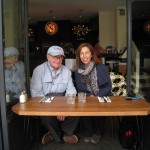
Merci, et bon soir, Monsieur Hemingway.


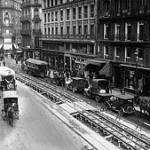
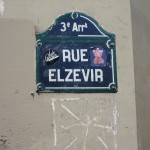
 I finally made it to Paris after a bit of drama in getting away. Due to a family illness, the trip was touch and go as to whether or not we were going to get there at all. Emergency rooms, doctor appointments (not for me; I was packed and set to board that plane) but two days later, after a doctor cleared the trip, we arrived in Paris.
I finally made it to Paris after a bit of drama in getting away. Due to a family illness, the trip was touch and go as to whether or not we were going to get there at all. Emergency rooms, doctor appointments (not for me; I was packed and set to board that plane) but two days later, after a doctor cleared the trip, we arrived in Paris.
We had rented an apartment in the Marais district and it was perfect. There were two flights of stairs to lug baggage up but it was not too tough and the climb was worth it. The apartment was both quaint and modern. It was bright and sunny with a wonderful galley kitchen. We marveled over the storage in the modest space. I immediately checked out the WIFI and it worked as if I were home in Connecticut. I’d brought my own hotspot anticipating a glitch but there was none.
The neighborhood was very walkable. Once outside our lovely garden courtyard, I strolled narrow streets, ducked into little hidden parks, heard a band playing in the street in the middle of the day. Better yet, couples took to the street dancing and an old lady danced solo up near the band. It was at that moment that after being in Paris one hour that I knew it would capture my soul.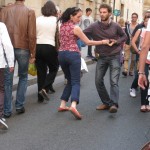
It was just a few steps around the corner to a bakery with fresh baguettes and croissants. Cheese and supplies were handy from a nearby small grocery.
I launched my Hemingway search on day one. While, of course, Paris has changed vastly since Hemingway was there, but still there are some memorable spots that are not much changed. Shakespeare & Company is still there minus Sylvia Beach. Les Deux Magots is still there, although it’s now a very busy corner. I had fun pretending that Hemingway was sitting at a corner table, deep in thought and writing what ultimately became The Sun Also Rises or one of his reporting pieces that kept the family afloat while he waited for his big break.
I walked the Hemingway walk along the Seine, up to Montmartre and saw the first apartment that he and Hadley shared. Obviously it’s occupied but I saw where it was. I was recently listening to some tapes that Alice Sokoloff had made of conversations with Hadley and which ultimately went into her book about Hadley. Hadley described in this conversation the bad neighborhood that she and Hemingway lived in when they first arrived in Paris, the unpleasant smells from the nearby businesses, and her loneliness in Paris. I’d never been as aware of that fact prior to listening to the tape. I had the impression that Hadley was happy in Paris because Hemingway was happy, but she described how difficult it was without knowing the language and given the fact that he was away during the day writing. She felt alone and an outsider. She was very homesick. She ultimately came to love Paris and willingly stayed there and even after moving back to Chicago with her second husband Paul Mowrer, she and Paul went back to live in Paris for a few years after the war. A Moveable Feast describes well the foods, the sights, and the smells in Paris in those early years. It was my dream to go and see these places while knowing they had changed, and it exceeded my expectation.

Aside from the Hemingway connection, I found Paris to be the most lovely city I’ve ever been in and I can’t wait to go back. I truly fell in love with it. I did not meet one surly French person. I speak a little French but far from well. Still, everyone was simply wonderful; the food was terrific and we weren’t eating at five-star restaurants and I felt welcome and everyone we met was very friendly. I am obsessed with the Eiffel Tower, the Seine, the Love Lock Bridge, the Pont Neuf, the Rodin Museum. I would go back in a split second and I will. To Hemingway’s Paris, then and now. Below: me at the Place des Voges.
Below: me at the Place des Voges.
The Sun Also Rises did have a different beginning when Hemingway first wrote it. Apparently, Scott Fitzgerald suggested that Hemingway begin later in the story and crossed out the beginning Hem had slated for the novel. He followed that advice and the rest is history.
Or not. A new edition shows Hemingway’s original placement of paragraphs. For background, please see Hemingway reworked.
Nice article about places to visit and feel Papa’s memories. I did not know that his usual seat at La Flordita in Havana was blocked off and a daiquiri placed on the counter daily near his statue. I have it on good authority that his favorite drink however was a mega-cold Martini. However, a daiquiri will do. Hem Places
 A few posts ago, I mentioned that there is a new computer program that helps you write like Hem. It pares down; it eliminates those pesky adverbs and adjectives; it tightens up. so what happened when Hemingway’s own works were put through the computer filter? well take a look.
A few posts ago, I mentioned that there is a new computer program that helps you write like Hem. It pares down; it eliminates those pesky adverbs and adjectives; it tightens up. so what happened when Hemingway’s own works were put through the computer filter? well take a look.
So there it is!




I mentioned last post that I’ve been re-reading Hemingway’s novels. I finished A Farewell to Arms and Across the River and into the Woods. I found so much more to love in A Farewell to Arms than my first few times around. While Catherine is dated in her attitude and her fawning for love, she still was working, living on her own, and in love. Frederic goes from looking for a fun time so loving Catherine deeply. I loved the scenes with Rinaldi and when he calls Frederic “baby.” Wonderful novel.
Across the River was not on the “best” list, At times, I found it hard to get through but it picked up in the end and I liked it but didn’t understand what The Colonel saw in Renata. She was young and beautiful but vapid and not even very spirited. However, Hemingway too was in love when writing it and Adriana, his prototype for Renata,was being seen through his eye. Still not a favorite. I liked the sense of Venice but not too much else.

Read “Hemingway’s Best Novels” for yourself. Link below.
This was a fun article to read. The comments were just as much fun because everyone has an opinion. It is interesting to see which novels are preferred, and whether only purists love the short stories best. I found the insights to be illuminating. My favorite novel is For whom the Bell Tolls, and among the short stories, I love The Snows of Kilimanjaro and A Clean Well-Lighted Place. The end of Something is also one I reread often.

You?
It is not surprising to me that there continues to be so much interest in Hemingway even 53 years after his death. As far as I know, the following movies are in the works.


1) A Moveable Feast, being either directed or produced by Mariel Hemingway. No word on who will be in it.
2) Hemingway and Fuentes, being produced and directed by Andy Garcia. Gregorio Fuentes was Hemingway’s Captain of the Pilar and also good friend. Hemingway was to be played by Anthony Hopkins, now replaced by Jon Voigt. I believe that Andy Garcia will be playing Gregorio Fuentes.
3) I don’t know the title but there is a movie in production about Maxwell Perkins, Hemingway’s editor (also Fitzgerald’s editor) to be played by Colin Firth. It focuses however on Perkins’ tempestuous relationship with James Jones (From Here to Eternity) more than on Hemingway or Fitzgerald but I’m sure both will figure prominently.

Two fairly recent books have come out: Rene Villarreal, Hemingway’s Cuban Son. I just bought it and have not had a chance to read it yet. Rene was Hem’s major duomo at his Cuban home, The Finca Vigia. It sounds like a sweet and lovely portrayal.

Hemingway Wives: This is a book about Hem’s wives through each one’s point of view. Apparently the author most identified with Pauline which is a change from most books. Most relate to Hadley or Martha. I have mine on pre-order.
I myself am working on a Hemingway themed novel. When far enough along, I’ll share some. I am pretty excited about it and hope that I can write it as well as I see it in my mind.
And that’s me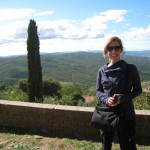 following the Hem trail in Italy. I am not sure there is a Hemingway trail but of course there is Venice, the places that he went in the war, and Rapallo where I did spend time. I enjoyed the hotel where he wrote “The Cat in the Rain,” one of my favorites.
following the Hem trail in Italy. I am not sure there is a Hemingway trail but of course there is Venice, the places that he went in the war, and Rapallo where I did spend time. I enjoyed the hotel where he wrote “The Cat in the Rain,” one of my favorites.

As usual, Hemingway is in the news everywhere. So what’s new?
1.) There apparently is news that there is a computer program that can predict whether you or I are the next Hemingway. You can send in a sample of your writing and the computer can tell you if you are in line with his style or just another wannabe. 

We all know that there is so much more that went into his writing than on the surface. One of the prime theories that Hem put to the test was the iceberg theory. For every sentence that he wrote on the paper, there were ten that didn’t get down on the paper but that were distilled into making that one sentence. When Hemingway wrote about a waiter, he–in his head–knew the waiter’s whole history and it was his theory that by knowing that history, even though it didn’t make it to the paper and the story, it added some texture to what eventually got into the story. He wrote the ending to A Farewell to Arms thirty-nine times and he wrote the last sentence of the The Sun Also Rises “Isn’t it pretty to think so?” many, many times until it had the exact inflection he wanted. No program can take that into account. So good luck with that computer

program!
2.) The John Fitzgerald Kennedy Library has received a shipment of new documents that it has added to its Hemingway collection. One that is particularly interesting is the telegram by which Hem was advised that he’d won the Nobel Prize for literature. It was sent to him on October 28, 1954 at 11:00 a.m. It said:
At its session today the Swedish Academy decided to award you the 1954 Nobel Prize for literature and I would accordingly request you to notify me if you accept this award and whether in that case it would be possible for you to be present in Stockholm on Nobel Bay December 10 to receive the prize from the hands of His Majesty the King. Anders Obersterling, Permanent Secretary of the Swedish Academy, 7:00 p.m.
Hemingway was not in good enough health to go to Sweden. He’d just survived two plane crashes in Africa and, while he put on a brave face, the second crash left him impaired for life with pain that never went away. He wrote a brief statement that was read by John C. Cabot, the then U.S. Ambassador to Sweden.
While Hemingway told the press that Carl Sandburg, Isak Dinesen, and Bernard Berenson were far more deserving of the honor, but he could use the prize money so he accepted, I have to believe he was pleased. He should have won it for For Whom the Bell Tolls and fortunately he won it eventually for The Old Man and the Sea.
It’s wonderful to listen to him making the speech, which he made after the fact and recorded. The beginning of it goes as follows:
“Having no facility for speech making and no command of oratory nor any domination of rhetoric, I wish to thank the administrators of the generosity of Alfred Nobel for this prize.
No writer who knows the great writers who did not receive the price can accept it other than with humility. There is no need to list these writers. Everyone here may make his own list according to his knowledge and conscience….Writing, at best, is a lonely life. Organizations for writers palliate the writer’s loneliness, but I doubt if they improve his writing. He grows in public stature as he sheds his loneliness and often his work deteriorates. For he does his work alone and if he is a good enough writer, he must face eternity, or lack of it, each day….I have spoken too long for a writer. A writer should write what he has to say and not speak it. Again, I thank you.”
At his best, he was an amazing class act.